小学英语说课稿全英三年级
小学英语说课稿全英

小学英语说课稿,全英篇一:小学英语说课稿(全英版)小学英语说课稿①Good afternoon , Ladies and Gentlemen !My name is Wu Dan . I come from Tanggangzi School .I am very glad to be standing here and talking about Lesson 10 ,which is from Fun with English Book 3 Unit 2 .My teaching report includes four parts . Part 1 To analyze the bookare 3 units in Book 3 . This is Lesson 10 . The central item is how to master another sentence to express “What’s the time ? ”and how to buy something. Using “What’s the time ? ”hungry , cakes, bread and so on . We’ll study and drill the sentences and the word ’s pronunciation .2. According to the teaching outline and combining the students ’situation , I make the teaching aims of this lesson as follows .a .The first is the aim of knowledge .It’s to learn and master two sentences. What time is it? I am hungry and then using them to expressthe time and go shopping fluently and freelyb. The second is the aim of abilitiesThe creative spirit is quite important to the students. So I will pay much attention to train it in my class. Otherwise. I will try to train the students listening, speaking, reading and writing abilities, Mainly improve their communicative abilities and encourage them to speak more English.C. The third is the aim of emotionMake the students have successful feeling and achievement. And make them be in English study. pointsThe first is to master and use the two sentences. What time is it? I’m hungry. The second is to master the usage of the words hungry, cakes and bread. points.It’s the pronunciation of the two words. hungry, cakes, and how to use them fluently and freely . Part 2 . Teaching and learning methodsMake the students take part in class . Ask and answer in pairs and groups . I’ll use communicative method , discussing method and seeing and hearingmethod to teach this lesson .Part 3 . Teaching aids .In order to interest the students . I’ll use a clock , recorder , cards and some food as my teaching aids . Part 4 . Teaching procedure .Step 1 RevisionBefore my class , I’ll get the students to sing an English song to keep themselves relax . Then I’ll use a clock to act it . What’s the time ? What’s the time ? It’s eight o’clock . I’ll show three numbers . When the students answer It’s ten o’clock . I’ll say : It’s ten . Today we’ll learn Lesson Ten . Then I'll put the clock on the blackboard .Step 2 Presentation and drillFirst I’ll point to the clock and ask , what time is it ? Students answer It’s ten . Then I go on moving the hands and ask .What time is it ?Students answer quickly .Second I’ll drill the sentences What time is it ? It’s ----- .pairs in pairs or row by row .Third When the students answer It’s 12:00 o’clock . I’ll point to my stomach and say .Oh I’mhungry .and I’ll eat a cake . Then I’ll go on saying I’m hungry .and I’ll eat another cake . I’ll act it four or five times . Then I ask a student to act it . I’m hungry , too . I’ll say two cakes , please .and the sentences .I’m hungry . Two cakes ,please.Forth :Listen to the dialogue and answer my questions.time is it?many cakes?Step 3 ConsolidationI’ll train the creative spirit of the students.I’ll give them three please. To act the dialogue freely .First at the 219 Park,second fruit shop Third department store.Encourage my student to the market to buy something with his friends or parents.②Good morning, everyone!Today, I’ll say something about Unit 9 Part A in Book 4 of Oxford English.Background on the reformation of curriculum, this book can connect the life and act, emphasize the interest and experience of the Ss, the pictures areactive and vivid. Grade four is the initial stage of English learning, so it stresses on the emotion of the Ss, creates a well beginning for the Ss. This Unit has 7 parts, we’ll learn Part A mainly, it embodies the repeating characterize. Review the learned language points “Where’s…”and the new language points will be represented in the following units. So this unit forms connecting links with a special meaning in this book.The content of this period is to use “Where’s\are…”to determine the place. And according to the contents and the fact of the Ss, I establish the following three teaching aims of this period:The first one: students can listen, read, say and spell the following words: a glass, a fridge, an egg, bread and a table.The second one: students can listen, read, say and write the following daily expressions: What’s for breakfast?Have some juice then.The third one: students can listen, read, say and write the following sentence patterns: Where’s\Whereare the\my…It’s \They’re…There’s no …in \on \near…I think the most difficult point of this period is to make sure the students can use the patterns “Where’s\Where are…and There is no …in\on\near…”in their daily life correctly.And I will use some pictures, words and sentence cards, a tape recorder and the multi-media computer to help me achieve the aims.The task-based method, communicated method, group cooperate method will be used in this period. To accomplish the aims, I design the following steps: Step 1 Songs and the game arousers the emotion.In order to attract the Ss’attention and construct an atmosphere of learning English, I let the students sing some English songs and play the game “Simon says”. At the same time the game can review the prep, serve the knowledge as foil and consist the appearance of the knowledge.Step 2 Change class to life, happy to say.The substance of language is communication andthe environment of communication is life. So when I present the sentence pattern “What’s for breakfast?”I first show a clock to elicit the time for breakfast, teach the sentence. Then show my own photo of having breakfast, Ss ask and guess. In this way I can attract Ss’attention, encourage Ss to ask Qs with the new knowledge.Most of the Ss have learnt the sentence pattern: Where’s…? so I design a task for Ss to help Helen find the food and drinks for breakfast, and teach the new language points: Where are…? They’re …Meanwhile stick the sentences on the Bb.After some practice by asking and answering, I present the next language points:There’s no …in\on\near…Have …then.And I will stick these sentence patterns on the Bb. Finally I’ll let the Ss do pair works to consolidate them. Step 3 Listen to the tape and Ss imitate to read and say.As the new reformation of curriculum, emphasized the traditional class attach importance to the mechanical teaching, neglect the experience andparticipation, for example, the five-step method. So in this lesson, after presentation, I ask Ss to listen to the tape with three Qs, read in different roles and in pairs, then try to recite the text.Step 4 Ss be the main body, T makes a guider.In class, Ss play as a host, and the T makes an influence on guiding, help Ss to act the learnt dialogue, it can stress the position of the Ss, and arouse their interest.Then I show a carton with no voice, ask Ss to make a dialogue in pairs.There are lots of ways to consolidate the new knowledge. Playing game is a good way. So according to the physiology of Ss, I hold a group competition during the game, ask Ss to finish the blanks. In this way can develop Ss’good habits and achieve the aim of mastering the learned knowledge in situation. Step 5 Change class to life, learn by themselves.Is this the end of the class? I don’t think so. If there is an end, I think it should be in the life. So I extend this class, encourage Ss to use the learned to communicate with each other in their life.In a word, the whole period is based on tasks, which are designed from easy steps to steps that are challenging. When the Ss are carting out the tasks, they can acquire information, knowledge, and have their ability and skills trained.That’s all. Thanks a lot for your attention.全英说课稿Good morning everyone. Standing here, I’m very happy and excited. It’s my greathonor to be here to present my lesson, and the chance is very precious for me. And I’ll try my best. Today I’ll talk about unit frommy contents consist of 8 parts Analysis of the teaching materialAnalysis of the studentsTeaching methodsTeaching aims and demandsTeaching aidsTeaching procedureBlackboard designAnd conclusionWell, firstly, I’ll talk about part 1 analysis of the teaching material. I have concluded the features of…….1 . there are a lot pictures. For this, the kids will be interested in the book. As we all know that interest is best teacher for the students.2. It lays stress on the communication. According to the problem of Chinese students learning English , the book design a lot of material to improve the students’ability of listening speaking, reading, and writing. So I think the book is very good.Then I’ll talk about next part analysis of the students. It is known to us that the kids are very active and like playing games very much, so during my class, I’ll design some interesting games to activate them to participate and learn something. They will also be interested in the class.Next I’ll talk about teaching methods. My teaching methods are task-based approach and situational approach. Using different methods can make the class active.Let’s move on to another part, teaching aims and demands. There are knowledge aims and ability aims.Knowledge aims are to enable the students to master the words and phrases:………. And thesentences:…Ability aims are To improve students’listening and speaking ability by reading and practicing the dialogue.Next is the teaching aids. In this class, I’ll use pictures, PPT and tape recorder. These can arouse the students’interest in English.Now I’ll talk about most important part teaching procedure. It consists of 5 steps. Warning up, lead-in, contents key points and difficult points and homework. Step1 is warming up. Here I’ll use PPT to play a English song Bingo for the students and I’ll ask them try to follow it to sing together. By this, the students can be interested in it and pay their attention to our class easily and improve their ability of speaking.Step2 is lead-in (导入按照所授内容设计,可通过展示与本课有关的话题或图片等等引出本课话题)Step 3 is contents(本部份为主要讲课内容及组织的课堂活动。
小学三年级英语课优秀说课稿3篇
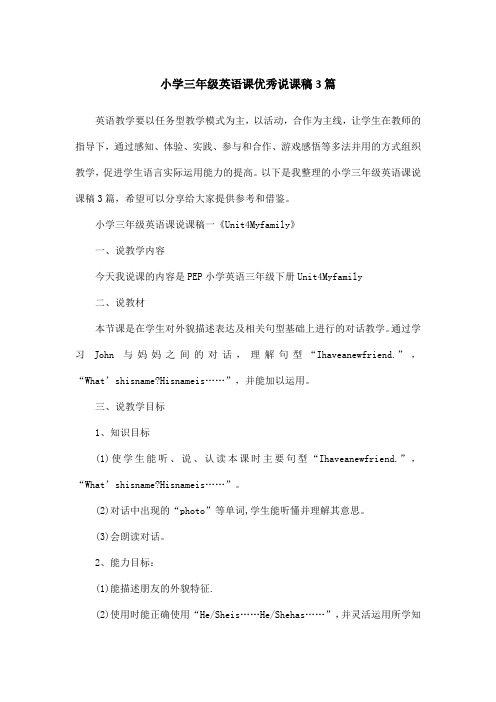
小学三年级英语课优秀说课稿3篇英语教学要以任务型教学模式为主,以活动,合作为主线,让学生在教师的指导下,通过感知、体验、实践、参与和合作、游戏感悟等多法并用的方式组织教学,促进学生语言实际运用能力的提高。
以下是我整理的小学三年级英语课说课稿3篇,希望可以分享给大家提供参考和借鉴。
小学三年级英语课说课稿一《Unit4Myfamily》一、说教学内容今天我说课的内容是PEP小学英语三年级下册Unit4Myfamily二、说教材本节课是在学生对外貌描述表达及相关句型基础上进行的对话教学。
通过学习John与妈妈之间的对话,理解句型“Ihaveanewfriend.”,“What’shisname?Hisnameis……”,并能加以运用。
三、说教学目标1、知识目标(1)使学生能听、说、认读本课时主要句型“Ihaveanewfriend.”,“What’shisname?Hisnameis……”。
(2)对话中出现的“photo”等单词,学生能听懂并理解其意思。
(3)会朗读对话。
2、能力目标:(1)能描述朋友的外貌特征.(2)使用时能正确使用“He/Sheis……He/Shehas……”,并灵活运用所学知识进行交流的能力.3、情感目标(1)教育要学生珍惜友谊,并热于助人。
(2)激发学生学习英语的兴趣,使学生树立学习英语的自信心。
(3)培养学生的合作交流能力。
四、说教学重点和难点He/Sheis……He/Shehas……的运用五、说学生学生在本单元已分别学习了“He/Sheis……He/Shehas……”,还不扎实,需进一步强化。
六、说教学准备教师准备动物单词卡、人物头饰、多媒体、投影仪、奖励用的小贴画,自制人物奖励卡。
七、说教法、学法为突破这堂课的重、难点,根据小学生好奇、好胜、好动、模仿力和表现欲旺盛等特点,我主要采取了以任务型教学模式为主,以活动,合作为主线,让学生在教师的指导下,通过感知、体验、实践、参与和合作、游戏感悟等多法并用的方式组织教学,促进学生语言实际运用能力的提高。
小学英语全英说课稿
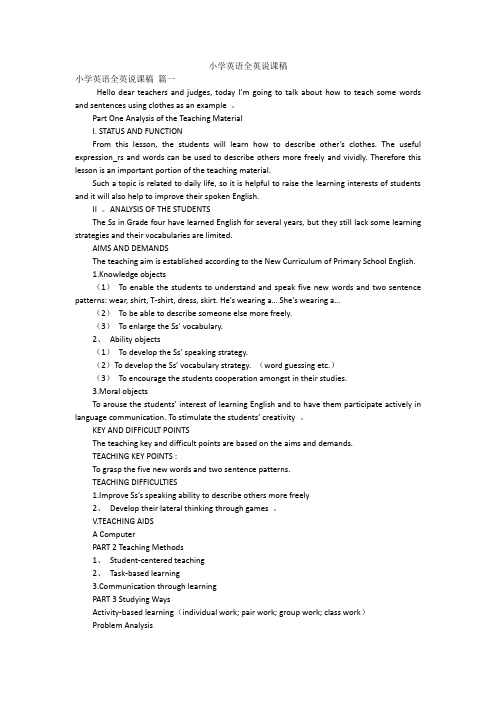
小学英语全英说课稿小学英语全英说课稿篇一Hello dear teachers and judges, today I’m going to talk about how to teach some words and sentences using clothes as an example 。
Part One Analysis of the Teaching MaterialI. STATUS AND FUNCTIONFrom this lesson, the students will learn how to describe other’s clothes. The useful expression_rs and words can be used to describe others more freely and vividly. Therefore this lesson is an important portion of the teaching material.Such a topic is related to daily life, so it is helpful to raise the learning interests of students and it will also help to improve their spoken English.II 。
ANALYSIS OF THE STUDENTSThe Ss in Grade four have learned English for several years, but they still lack some learning strategies and their vocabularies are limited.AIMS AND DEMANDSThe teaching aim is established according to the New Curriculum of Primary School English.1.Knowledge objects(1)To enable the students to understand and speak five new words and two sentence patterns: wear, shirt, T-shirt, dress, skirt. He’s wearing a… She’s wearing a…(2)To be able to describe someone else more freely.(3)To enlarge the Ss’ vocabulary.2、Ability objects(1)To develop the Ss’ speaking strategy.(2)To develop the Ss’ vocabulary strategy. (word guessing etc.)(3)To encourage the students cooperation amongst in their studies.3.Moral objectsTo arouse the students’ interest of learning English and to have them participate actively in language communication. To stimulate the students’ creativity 。
小学三年级英语说课稿示例三篇
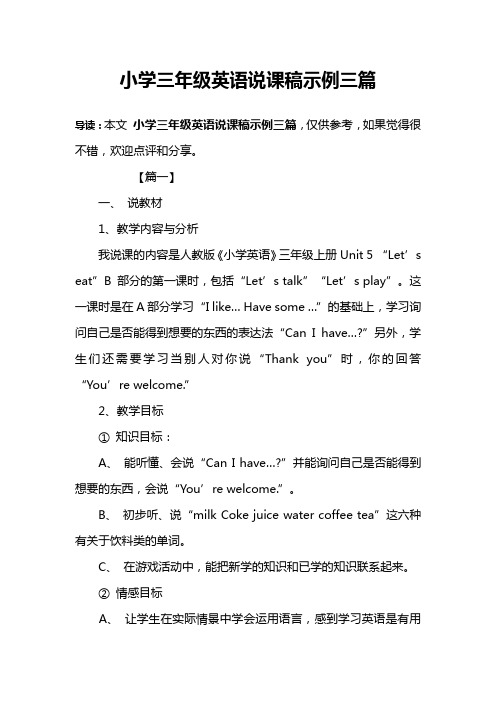
小学三年级英语说课稿示例三篇导读:本文小学三年级英语说课稿示例三篇,仅供参考,如果觉得很不错,欢迎点评和分享。
【篇一】一、说教材1、教学内容与分析我说课的内容是人教版《小学英语》三年级上册Unit 5 “Let’s eat”B 部分的第一课时,包括“Let’s talk”“Let’s play”。
这一课时是在A部分学习“I like… Have some …”的基础上,学习询问自己是否能得到想要的东西的表达法“Can I have…?”另外,学生们还需要学习当别人对你说“Thank you”时,你的回答“You’re welcome.”2、教学目标① 知识目标:A、能听懂、会说“Can I have…?”并能询问自己是否能得到想要的东西,会说“You’re welcome.”。
B、初步听、说“milk Coke juice water coffee tea”这六种有关于饮料类的单词。
C、在游戏活动中,能把新学的知识和已学的知识联系起来。
② 情感目标A、让学生在实际情景中学会运用语言,感到学习英语是有用的,产生成就感,从而能更好地提高学习英语的兴趣。
B、在学习活动中积极,好动,充满好奇,乐于尝试。
3、教学重、难点重点:① 能用“Can I have…?”来询问自己想要得到的东西② 能初步听、说“milk Coke juice water coffee tea”这六种有关于饮料类的单词。
难点:能准确听、说“milk Coke juice water coffee tea”这六种有关于饮料类的单词,并能在实际情景交流中适当而灵活运用。
4、说教学准备主要以现代化电教手段----多媒体辅助教学,贯穿整个教学过程,增加了直观性和趣味性,加大了课堂密度,提高教学效果。
二、说学情1、学习需要分析小学三年级学生具有好奇、好动、喜欢游戏,乐于参与和表演,对英语学习兴趣浓的特点,但这些并不能持久,因此,要创设一定的情景,让学生在情境中学习,多种教学手段交替使用,尽量利用实物、图片以及课件等直观教具进行教学,使学生始终处于新鲜,求知欲旺盛,学习情绪高涨的氛围中。
小学英语说课稿(英文版)范例【五篇】
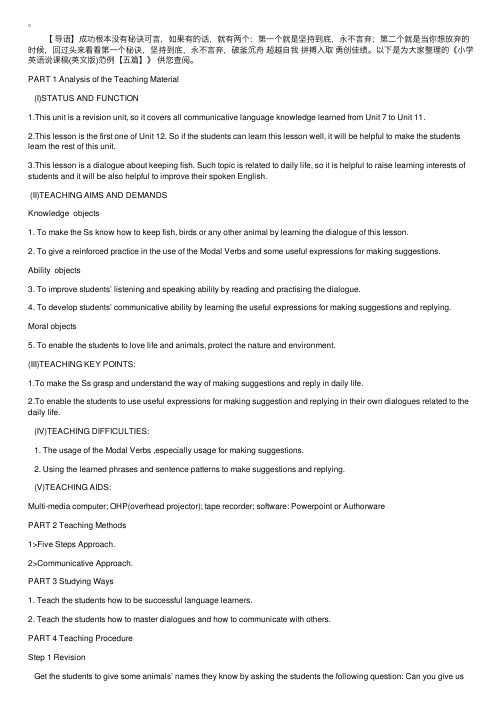
【导语】成功根本没有秘诀可⾔,如果有的话,就有两个:第⼀个就是坚持到底,永不⾔弃;第⼆个就是当你想放弃的时候,回过头来看看第⼀个秘诀,坚持到底,永不⾔弃,破釜沉⾈超越⾃我拼搏⼊取勇创佳绩。
以下是为⼤家整理的《⼩学英语说课稿(英⽂版)范例【五篇】》供您查阅。
PART 1 Analysis of the Teaching Material(I)STATUS AND FUNCTION1.This unit is a revision unit, so it covers all communicative language knowledge learned from Unit 7 to Unit 11.2.This lesson is the first one of Unit 12. So if the students can learn this lesson well, it will be helpful to make the students learn the rest of this unit.3.This lesson is a dialogue about keeping fish. Such topic is related to daily life, so it is helpful to raise learning interests of students and it will be also helpful to improve their spoken English.(II)TEACHING AIMS AND DEMANDSKnowledge objects1. To make the Ss know how to keep fish, birds or any other animal by learning the dialogue of this lesson.2. To give a reinforced practice in the use of the Modal Verbs and some useful expressions for making suggestions.Ability objects3. To improve students’ listening and speaking ability by reading and practising the dialogue.4. To develop students’ communicative ability by learning the useful expressions for making suggestions and replying. Moral objects5. To enable the students to love life and animals, protect the nature and environment.(III)TEACHING KEY POINTS:1.To make the Ss grasp and understand the way of making suggestions and reply in daily life.2.To enable the students to use useful expressions for making suggestion and replying in their own dialogues related to the daily life.(IV)TEACHING DIFFICULTIES:1. The usage of the Modal Verbs ,especially usage for making suggestions.2. Using the learned phrases and sentence patterns to make suggestions and replying.(V)TEACHING AIDS:Multi-media computer; OHP(overhead projector); tape recorder; software: Powerpoint or AuthorwarePART 2 Teaching Methods1>Five Steps Approach.2>Communicative Approach.PART 3 Studying Ways1. Teach the students how to be successful language learners.2. Teach the students how to master dialogues and how to communicate with others.PART 4 Teaching ProcedureStep 1 RevisionGet the students to give some animals’ names they know by asking the students the following question: Can you give ussome names of different animals you know? This step is employed to revise the words related the animals. At the same time draw the students’ attention to the topic about animals.Step 2 Lead-inSign to the students to be quiet and close their books. Then start a free talk with the students. Use computer to show some pictures of different pets, such as dogs, cats etc. Ask the students several questions about raising pets. These questions are employed to warm up the students and raise the interests of the students to speak English in class on the topics they like and familiar with.Good morning, everyone!Today, I’ll say something about Unit 9 Part A in Book 4 of Oxford English.Background on the reformation of curriculum, this book can connect the life and act, emphasize the interest and experience of the Ss, the pictures are active and vivid. Grade four is the initial stage of English learning, so it stresses on the emotion of the Ss, creates a well beginning for the Ss. This Unit has 7 parts, we’ll learn Part A mainly, it embodies the repeating characterize. Review the learned language points “Where’s…”and the new language points will be represented in the following units. So this unit forms connecting links with a special meaning in this book.The content of this period is to use “Where’s\are…” to determine the place. And according to the contents and the fact of the Ss, I establish the following three teaching aims of this period:The first one: students can listen, read, say and spell the following words: a glass, a fridge, an egg, bread and a table.The second one: students can listen, read, say and write the following daily expressions: What’s for breakfast?Have some juice then.The third one: students can listen, read, say and write the following sentence patterns: Where’s\Where are the\my…It’s \They’re…There’s no …in \on \near…I think the most difficult point of this period is to make sure the students can use the patterns “Where’s\Where are…and There is no …in\on\near…” in their daily life correctly.And I will use some pictures, words and sentence cards, a tape recorder and the multi-media computer to help me achieve the aims.The task-based method, communicated method, group cooperate method will be used in this period.To accomplish the aims, I design the following steps:Step 1 Songs and the game arousers the emotion.In order to attract the Ss’ attention and construct an atmosphere of learning English, I let the students sing some English songs and play the game “Simon says”. At the same time the game can review the prep, serve the knowledge as foil and consist the appearance of the knowledge.Step 2 Change class to life, happy to say.The substance of language is communication and the environment of communication is life. So when I present the sentence pattern “What’s for breakfast?” I first show a clock to elicit the time for breakfast, teach the sentence. Then show my own photo of having breakfast, Ss ask and guess. In this way I can attract Ss’ attention, encourage Ss to ask Qs with the new knowledge.Most of the Ss have learnt the sentence pattern: Where’s…? so I design a task for Ss to help Helen find the food and drinks for breakfast, and teach the new language points: Where are…?They’re … Meanwhile stick the sentences on the Bb.After some practice by asking and answering, I present the next language points:There’s no …in\on\near…Have …then.And I will stick these sentence patterns on the Bb. Finally I’ll let the Ss do pair works to consolidate them.Step 3 Listen to the tape and Ss imitate to read and say.As the new reformation of curriculum, emphasized the traditional class attach importance to the mechanical teaching, neglect the experience and participation, for example, the five-step method. So in this lesson, after presentation, I ask Ss to listen to the tape with three Qs, read in different roles and in pairs, then try to recite the text.Step 4 Ss be the main body, T makes a guider.In class, Ss play as a host, and the T makes an influence on guiding, help Ss to act the learnt dialogue, it can stress the position of the Ss, and arouse their interest.Then I show a carton with no voice, ask Ss to make a dialogue in pairs.There are lots of ways to consolidate the new knowledge. Playing game is a good way. So according to the physiology of Ss, I hold a group competition during the game, ask Ss to finish the blanks. In this way can develop Ss’ good habits and achieve the aim of mastering the learned knowledge in situation.Step 5 Change class to life, learn by themselves.Is this the end of the class? I don’t think so. If there is an end, I think it should be in the life. So I extend this class, encourage Ss to use the learned to communicate with each other in their life.In a word, the whole period is based on tasks, which are designed from easy steps to steps that are challenging. When the Ss are carting out the tasks, they can acquire information, knowledge, and have their ability and skills trained.Thank you!。
小学三年级英语说课稿4篇

小学三年级英语说课稿4篇小学三年级英语说课稿4篇说课稿是为进行说课准备的文稿,它不同于教案,教案只说“怎样教”,说课稿则重点说清“为什么要这样教”。
以下是小编整理的小学三年级英语说课稿,希望对大家有帮助!小学三年级英语说课稿1一、说教材《My home》这一单元的教学内容都是围绕“家”这一学生喜闻乐见的主题展开的。
这节课为新授课,是第四单元第一课时,也是A 部分的第一课时,有Let’s learn和Let’s do。
这节课的教学内容是要学习有关房间的五个单词及进行简单的对家的介绍。
句型Go to…和五个房间有关的动作短语,这些短词汇都是学生在日常生活中经常见到的事物,与小学生的生活和学习密切相关。
本课时是本单元的重点,本节课掌握程度的好坏,直接会影响到本单元后阶段有关“描述和询问东西在哪里”的对话和故事的掌握,在本单元教学中具有举足轻重的地位。
依据本单元的话题,本节课的内容和学生现有的认知水平确定以下教学目标:(一)能够听说,认读五个新单词“study l iving room. Kitchen,bathroom,bedroom.”(二) 能听懂“let’s do”的指令,并做出相应的动作,能用“Thisis my home,This is a living room...”句型简单介绍房子。
(三)培养学生口语表达,交际能力,培养学生对家的热爱,鼓励学生大胆设想自己未来的家居。
这样确定教学目标,使“三维”目标紧密结合,在同一教学过程中,互相渗透,共同完成,而且目标具体,可检测。
由于本课是第四单元的新授课,将训练学生听、说、认读新单词的能力以及听懂“Let’s do”部分中指令并做相应的动作为教学重点。
《My home》part A Let’s do通过单词及指令的学习和掌握,能综合灵活运用所学语言,并描述卧室中的物件,并能据此编出对话做为本课的教学难点。
二、说教法在本节课的设计中,充分利用直观,实用的教具,吸引学生注意力激发许文胜兴趣,制作了课件,利用多媒体优势,创设佳境,在教法总体构思上注重学生听、说、唱、玩、演几方面能力的综合训练,采用直观教学法,TPR活动教学法,用游戏激发学生学习英语的兴趣,训练和形成学生的英语能力三、说学法因为教为学服务,所以在教学过程中,让学生仔细听音,观察老师发音口型,认真模仿,让学生分组练习,用玩游戏的方式进行知识的巩固,通过学生动脑、动口、动手等方式,培养学生学习兴趣以及运用英语交际沟通的能力。
小学英语说课稿(精选10篇)
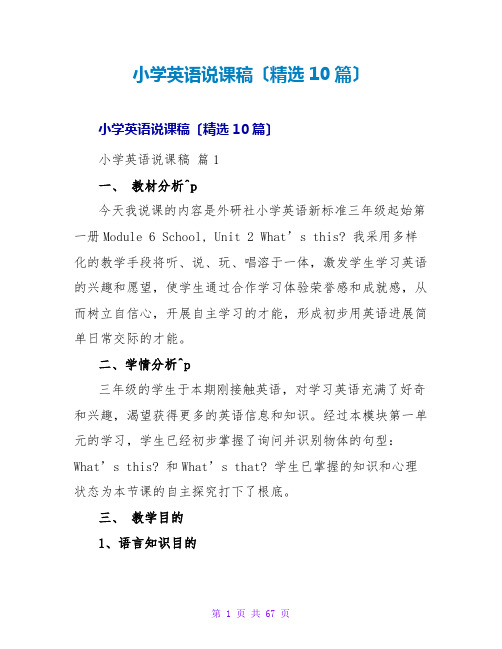
小学英语说课稿〔精选10篇〕小学英语说课稿〔精选10篇〕小学英语说课稿篇1一、教材分析^p今天我说课的内容是外研社小学英语新标准三年级起始第一册Module 6 School, Unit 2 What’s this? 我采用多样化的教学手段将听、说、玩、唱溶于一体,激发学生学习英语的兴趣和愿望,使学生通过合作学习体验荣誉感和成就感,从而树立自信心,开展自主学习的才能,形成初步用英语进展简单日常交际的才能。
二、学情分析^p三年级的学生于本期刚接触英语,对学习英语充满了好奇和兴趣,渴望获得更多的英语信息和知识。
经过本模块第一单元的学习,学生已经初步掌握了询问并识别物体的句型:What’s this? 和What’s that? 学生已掌握的知识和心理状态为本节课的自主探究打下了根底。
三、教学目的1、语言知识目的(1) 让学生能听、说、认、读pen,pencil,book,bag等单词。
(2) 通过学习让学生纯熟掌握句型What’s this? 和What’s that?2、学习技能目的:(1) 能听懂Let’s do中的指令并做出相应动作,如Point to th e …(2) 根据图片或在场景下进展简单的英语交流和表达,培养学生灵敏运用所学知识进展交流的才能.3、情感态度目的(1) 通过学习活动,使学生有兴趣听、说英语,培养学生注意观察、乐于模拟的良好习惯和主动竞争的竟识。
(2) 让学生在鼓励性评价中树立学习英语的自信心。
(3) 通过小组活动培养学生合作交流才能,从而让学生意识到学习英语的重要意义。
(4)充分利用教材所提供的学习资,实现自由参与与创新,能主动与别人交流,并克制交流中的困难,使交际顺利进展。
四、教学重难点1、学习新单词 pen,pencil,book,bag ,能正确认读。
2、稳固已学句型:What’s this? 和What’s that? 并能用It’s a…作出相应的答复。
五、课前准备教具准备:课文录音;带单词的物品图片;实物pen,pencil,book,bag;魔法包;奖品(贴画)。
小学英语英文说课稿(共6篇)
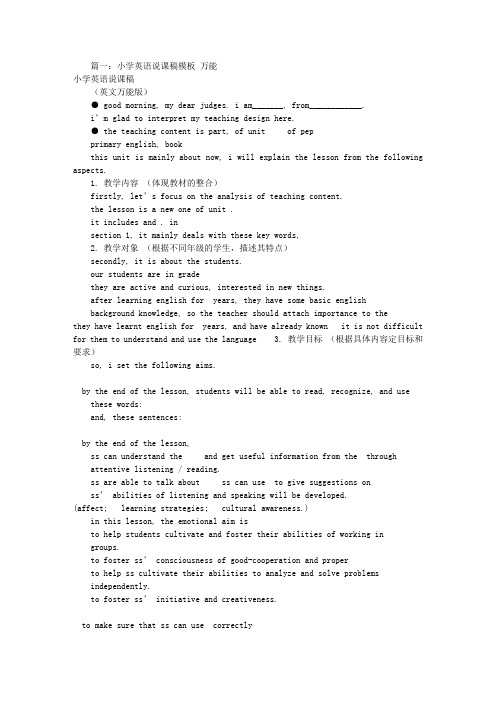
篇一:小学英语说课稿模板万能小学英语说课稿(英文万能版)● good morning, my dear judges. i am_______, from____________.i’m glad to interpret my teaching design here.● the teaching content is part, of unit of pepprimary english, bookthis unit is mainly about now, i will explain the lesson from the following aspects.1. 教学内容(体现教材的整合)firstly, let’s focus on the analysis of teaching content.the lesson is a new one of unit .it includes and . insection 1, it mainly deals with these key words,2. 教学对象(根据不同年级的学生,描述其特点)secondly, it is about the students.our students are in gradethey are active and curious, interested in new things.after learning english for years, they have some basic englishbackground knowledge, so the teacher should attach importance to thethey have learnt english for years, and have already known it is not difficult for them to understand and use the language 3. 教学目标(根据具体内容定目标和要求)so, i set the following aims.by the end of the lesson, students will be able to read, recognize, and usethese words:and, these sentences:by the end of the lesson,ss can understand the and get useful information from the throughattentive listening / reading.ss are able to talk about ss can use to give suggestions onss’ abilities of listening and speaking will be developed.(affect; learning strategies; cultural awareness.)in this lesson, the emotional aim isto help students cultivate and foster their abilities of working ingroups.to foster ss’ consciousness of good-cooperation and properto help ss cultivate their abilities to analyze and solve problemsindependently.to foster ss’ initiative and creativeness.to make sure that ss can use correctlyskillfully.to develop ss’ interest in english.the difficult point is:the pronunciation of 教法学法fourthly, it talks about teaching methods.andin this lesson, i will mainly use “task-based teaching method”,and so on.4. 教学过程①具体steps 根据具体内容定;②板书steps + purpose 说明;③如有可能,同时完成layout设计;next, let’s focus on the teaching procedures.i will finish the lesson in steps.it will cost about mins.after greeting with the ss, i will begin the lesson by singing the song together with the ss.purpose:the purpose of this is to form a better english learning surrounding forthe ss, and, at the same time, it provides situations to review the learnt knowledgefor the next step.it will cost about mins.with the help of the ppt, i set a situation of by to stimulate the ss’ interest of the lesson.by playing the ppt, iand then, (板书layout)the purpose of this is to present the new words and sentences in thesituation, which relates to the ss’ real life experiences, to help the ss understand the language easily and naturally.after presenting each new word (by the guessing game), i will impart theknowledge of pronunciation rules in teaching the new words.it is called phonics.it can facilitate the ss’ abilities to pronounce the words, and help them to remember the spelling of the words.(机械上口;有意义操练; let’s do; 课文对话表演;)it will cost mins, includingdue to the ss’ age, i make the purpose of this is to draw the whole ss’ attention to the spelling ofthe words.it is to help ss to learn through a true situation.in this step, i will give ss a free space to show their abilities.i willthen,used here.ability of cooperation will be well developed.making a new dialogue is to check if ss can use correctly and skillfully.(总结上课内容;德育渗透;作业布置;)in this step, i will guide the ss to conclude the key words and sentences and also, i will the purpose of this is to stimulate ss’ interest of learning english and5. 板书设计and, this is my layout design.that’s all for my teaching design. thank you a lot for listening. (gong) 篇二:小学英语说课稿:《what do you like》说课稿范文小学英语说课稿:《what do you like》unit 11 what do you like?说课稿1.说教材1.1教材内容本节教材的主要话题是food,功能为运用i like?.句型表达自己喜好什么食物,并在此基础上进行简单的语言交流。
小学三年级英语说课稿(精选14篇)

小学三年级英语说课稿小学三年级英语说课稿(精选14篇)作为一名老师,时常需要编写说课稿,说课稿可以帮助我们提高教学效果。
我们该怎么去写说课稿呢?下面是小编收集整理的小学三年级英语说课稿,欢迎阅读与收藏。
小学三年级英语说课稿1一、说教材我说课的内容是小学三年级开心学英语第二册第三单元,本课是功能型的交际型的交际训练课,我借助“任务型”教学采用多样化的教学手段将听、说、玩、演、唱溶于一体,激发学生学习英语的兴趣和愿望,使学生通过合作学习体验荣誉感和成就感从而树立自信心,发展自主学习的能力,形成初步用英语进行简单日常交际的能力。
结合新课程标准和大纲提出的基础教育阶段英语课程的总体目标和具体要求我将本课教学目标设计如下:语言知识目标:1、使学生掌握表达自己喜欢与不喜欢的句型:① Do you like … ?Yes , I do . ( No , I don’t . )② I like … .2、学习认读单词:soccer baseball badminton tennis basketball dodge ball volleyball ping-pong语言技能目标:①、使学生能够根据指令做动作。
②、根据图片和情境说出单词和句子。
③、在图文或场景下进行简单的英语交流和表演。
情感态度目标:通过本课学习使学生有兴趣听、说英语、背歌谣,做游戏、敢干开口,乐于模仿,在鼓励性评价中树立信心在小组活动中积极参与合作,从而意识到交流对于学习英语的重要意义。
充分利用教材和教师的多媒体教学所提供的学习资源,实现自由参与和创新,能主动与他人交流,并克服交流中的困难,使交际顺利进行。
文化意识目标:能够恰当使用英语表达自己的喜爱与不喜爱的事物、活动、各种运动等,在语言交流中交换被此情感信息。
结合教学目标的要求,我把本课的重难点设置为1、询问喜欢什么的句型:Do you like … ?2、对情境进行模仿,创新。
我主要通过感知新教材——设置——灵活运用这三个主要步骤来突破教材重难点的。
小学英语全英说课稿(精选10篇)
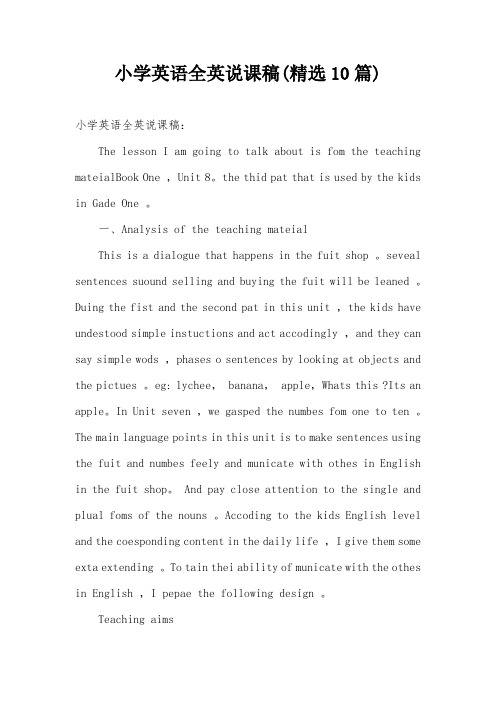
小学英语全英说课稿(精选10篇)小学英语全英说课稿:The lesson I am going to talk about is fom the teaching mateialBook One ,Unit 8。
the thid pat that is used by the kids in Gade One 。
一、Analysis of the teaching mateialThis is a dialogue that happens in the fuit shop 。
seveal sentences suound selling and buying the fuit will be leaned 。
Duing the fist and the second pat in this unit ,the kids have undestood simple instuctions and act accodingly ,and they can say simple wods ,phases o sentences by looking at objects and the pictues 。
eg: lychee, banana, apple,Whats this ?Its an apple。
In Unit seven ,we gasped the numbes fom one to ten 。
The main language points in this unit is to make sentences using the fuit and numbes feely and municate with othes in English in the fuit shop。
And pay close attention to the single and plual foms of the nouns 。
小学英语全英说课稿(10篇)
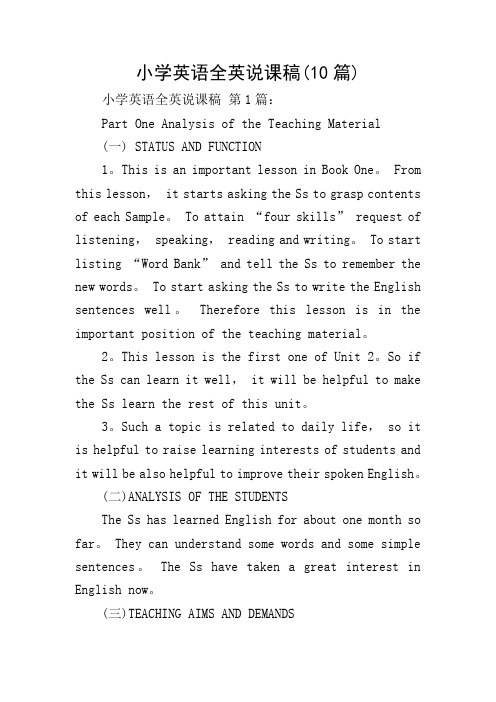
小学英语全英说课稿(10篇) 小学英语全英说课稿第1篇:Part One Analysis of the Teaching Material(一) STATUS AND FUNCTION1。
This is an important lesson in Book One。
From this lesson, it starts asking the Ss to grasp contents of each Sample。
To attain “four skills” request of listening, speaking, reading and writing。
To start listing “Word Bank” and tell the Ss to remember the new words。
To start asking the Ss to write the English sentences well。
Therefore this lesson is in the important position of the teaching material。
2。
This lesson is the first one of Unit 2。
So if the Ss can learn it well, it will be helpful to make the Ss learn the rest of this unit。
3。
Such a topic is related to daily life, so it is helpful to raise learning interests of students and it will be also helpful to improve their spoken English。
(二)ANALYSIS OF THE STUDENTSThe Ss has learned English for about one month so far。
PEP小学三年级英语说课稿三篇

【导语】⼀份优秀的说课稿,体现的不仅仅是教师的能⼒,更体现出教师对⼯作的热爱认真程度,通过说课稿,教师可以更好地展开教学,合理科学的规划使教学作⽤化。
以下是整理的相关资料,希望对您有⽤。
【篇⼀】Part B Let’s Learn &Let’s do说课稿教学指导思想:兴趣是的⽼师。
——爱因斯坦⼀、说教材:1. 教材分析:本节课是Unit 2 Part B Let's learn及Let's do中的内容,其中 Let's learn是在 Part A学习的基础上,学习 white, black, orange, brown 这⼏个词汇的,并围绕新授单词,学习句⼦及Let's do 部分。
2. 教学⽬标:(1) 知识⽬标:要求学⽣能听、说、认读单词 white, black, orange, brown。
(2) 能⼒⽬标:a. 初步运⽤句⼦:Colour it brown! OK!b. 能听懂指⽰语并按照指令做出相应的动作。
(3) 情感态度⽬标:培养学⽣对颜⾊的喜爱,欣赏颜⾊的美,乐意⽤颜⾊来描绘⽣活。
3. 教学重点和难点a. 重点:能正确熟练地认读表⽰颜⾊的新单词和运⽤句⼦。
b. 难点:单词 black与 brown的发⾳。
4. 学情分析:本教材的教学对象是三年级学⽣,他们对英语有着浓厚的学习兴趣,对⾊彩有着较强的敏感程度,这些都有利于新知识的教学,学⽣能在⽐较轻松的环境中学习新课内容。
5. 课前准备:单词卡⽚,颜⾊卡⽚,颜料和课件等。
⼆、说教法学法通过对以上教材的分析,结合教学重、难点,在本课时中我采⽤了情景教学法,全⾝反应法,多媒体辅助法和任务型教学法,以各种⽣动、形象、有趣的⼿段激发⼉童的兴趣,学⽣以游戏学习和⼩组合作法为主。
三、说教学过程我设计了以下的教学环节:1. 热⾝导⼊──歌曲开篇,引⼊情境。
2. 探究新知──启发诱导,教学新知。
3. 巩固延伸──创设情景,巩固新知。
小学英语说课稿(优秀3篇)

小学英语说课稿(优秀3篇)小学英语说课稿篇一一、教材分析本次说课我所使用的教材是义务教育课程标准实验教科书,小学三年级上册第四单元We Love Animals。
本套教材非常注重学生语言应用能力的培养,从学生的角度来讲,基础教育最主要的任务是要学会学习,开发自主学习能力,培养创新能力。
本教材在整体构思、内容安排、活动设计和教学方法都采用了与学生紧密联系的生活实际,真正体现了语言的交际功能,同时,它把知识和技能目标融会在了完成任务的过程之中,从而体现出了英语新课标提出的把话题---功能---结构---任务结合起来的总思路,为培养学生运用英语进行交流打下良好的基础。
1、本课教学内容(1) Lets learn本部分主要是学习常见动物单词cat dog monkey duck panda rabbit(2)Lets talk学习句型I have a …以及Super! Cool! Wow! Great!等表示赞美的感叹词语。
(3)Lets do.本部分要求学生在“Act like a”的指令下模仿小动物的动作。
2、本课教学目标:(知识目标、能力目标、德育目标)知识目标(1)能听懂,会说Look! I have a … 并能在实际情景中运用。
(2)能听说,认读一些常见的动物单词。
(3)能听懂,会说几个常用的感叹词Super!Cool!Wow!Great!并能够在实际情景中运用。
(4)能听懂简单的指示语,并能按照指令模仿动物做出相应的动作。
能力目标:提高学生听、说、读、写的综合能力。
德育目标:教育学生要爱护和保护小动物。
3、重难点的确定重点:能听说认读常见的动物单词,并能运用句型“Look! I have a ”难点:由于学生年纪小,对于一节课要正确运用所学句型和四种表达感叹的词,有一定的难度,而且特别容易混淆。
通过本课的学习,运用自然引入的方法帮助学生正确理解与使用重点句型和四个感叹词。
二、教材处理1、以“旧”引“新”依据知识迁移规律的新旧知识的内在联系,从已学过的知识引出要学的知识,从课前的日常对话引入单词教学。
小学三年级英语说课稿【五篇】
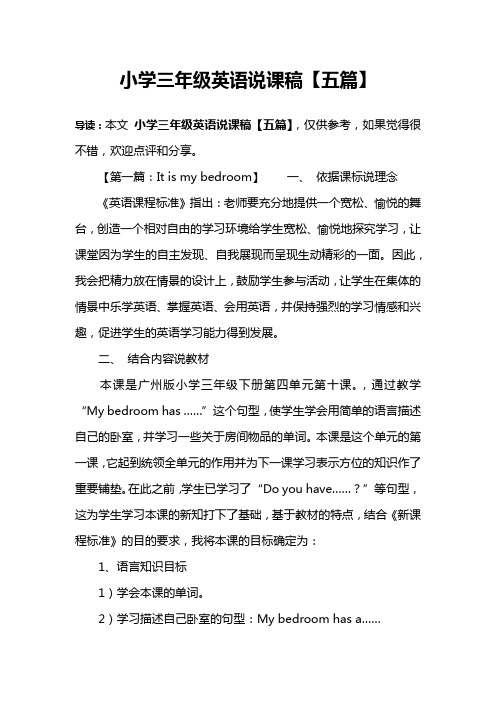
小学三年级英语说课稿【五篇】导读:本文小学三年级英语说课稿【五篇】,仅供参考,如果觉得很不错,欢迎点评和分享。
【第一篇:It is my bedroom】一、依据课标说理念《英语课程标准》指出:老师要充分地提供一个宽松、愉悦的舞台,创造一个相对自由的学习环境给学生宽松、愉悦地探究学习,让课堂因为学生的自主发现、自我展现而呈现生动精彩的一面。
因此,我会把精力放在情景的设计上,鼓励学生参与活动,让学生在集体的情景中乐学英语、掌握英语、会用英语,并保持强烈的学习情感和兴趣,促进学生的英语学习能力得到发展。
二、结合内容说教材本课是广州版小学三年级下册第四单元第十课。
,通过教学“My bedroom has ……”这个句型,使学生学会用简单的语言描述自己的卧室,并学习一些关于房间物品的单词。
本课是这个单元的第一课,它起到统领全单元的作用并为下一课学习表示方位的知识作了重要铺垫。
在此之前,学生已学习了“Do you have……?”等句型,这为学生学习本课的新知打下了基础,基于教材的特点,结合《新课程标准》的目的要求,我将本课的目标确定为:1、语言知识目标1)学会本课的单词。
2)学习描述自己卧室的句型:My bedroom has a……3)理解、朗读并尝试表演对话。
2、语言技能目标1)根据情景说出单词和句子。
2)在图文和场景下进行简单的英语交流和表演。
3、情感态度目标能有兴趣听说英语,敢于开口,乐于模仿,并在小组活动中积极参与合作,能主动用所学英语与他人交流。
结合教学目标的要求,我把重难点敲定为:重点:运用句型:My bedroom has a…描述自己的房间。
难点:1、wardrobe、ceiling等较难发音的单词的正确朗读。
2、对情景进行模仿、创新。
三、紧扣上述说教学策略1、教法:情景教学法:根据三年级学生活泼好动、好表现、喜表演等特点以及本课句型的情景性较强的特点,我会采用情景教学法,为学生设置真实有效的场景,让学生走进课文,表演课文,与文本展开零距离的对话,从而激发想说的愿望也有利于表达能力的提高。
小学三年级英语说课稿【三篇】
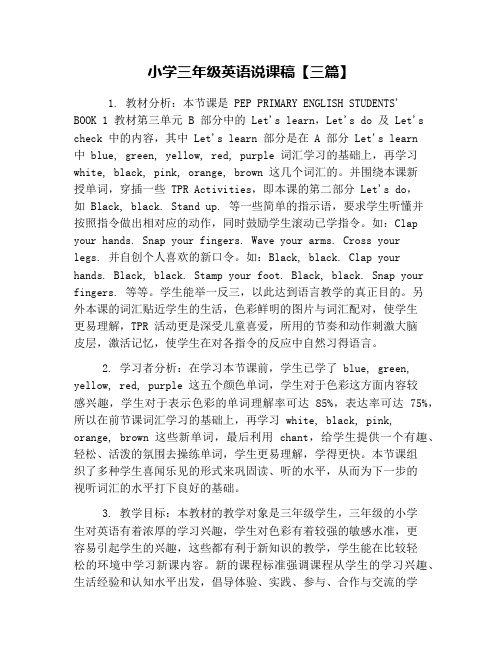
小学三年级英语说课稿【三篇】1. 教材分析:本节课是 PEP PRIMARY ENGLISH STUDENTS' BOOK 1 教材第三单元 B 部分中的 Let's learn,Let's do 及 Let's check 中的内容,其中 Let's learn 部分是在 A 部分 Let's learn中 blue, green, yellow, red, purple 词汇学习的基础上,再学习white, black, pink, orange, brown 这几个词汇的。
并围绕本课新授单词,穿插一些 TPR Activities,即本课的第二部分 Let's do,如 Black, black. Stand up. 等一些简单的指示语,要求学生听懂并按照指令做出相对应的动作,同时鼓励学生滚动已学指令。
如:Clap your hands. Snap your fingers. Wave your arms. Cross your legs. 并自创个人喜欢的新口令。
如:Black, black. Clap your hands. Black, black. Stamp your foot. Black, black. Snap your fingers. 等等。
学生能举一反三,以此达到语言教学的真正目的。
另外本课的词汇贴近学生的生活,色彩鲜明的图片与词汇配对,使学生更易理解,TPR 活动更是深受儿童喜爱,所用的节奏和动作刺激大脑皮层,激活记忆,使学生在对各指令的反应中自然习得语言。
2. 学习者分析:在学习本节课前,学生已学了 blue, green, yellow, red, purple 这五个颜色单词,学生对于色彩这方面内容较感兴趣,学生对于表示色彩的单词理解率可达 85%,表达率可达 75%,所以在前节课词汇学习的基础上,再学习 white, black, pink, orange, brown 这些新单词,最后利用 chant,给学生提供一个有趣、轻松、活泼的氛围去操练单词,学生更易理解,学得更快。
三年级英语说课稿范本【三篇】
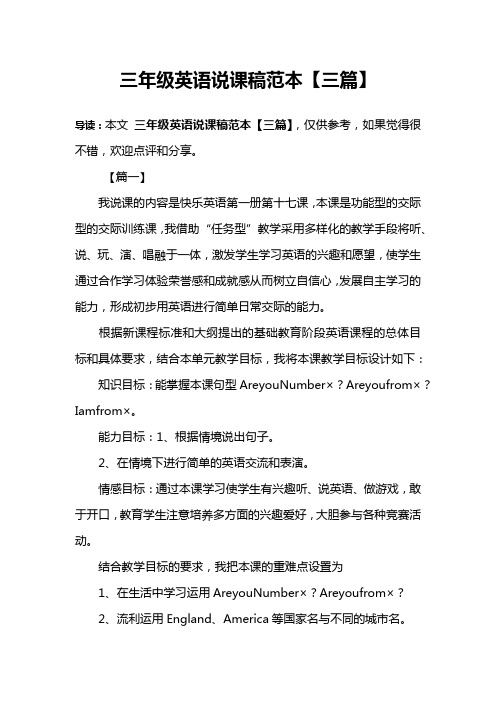
三年级英语说课稿范本【三篇】导读:本文三年级英语说课稿范本【三篇】,仅供参考,如果觉得很不错,欢迎点评和分享。
【篇一】我说课的内容是快乐英语第一册第十七课,本课是功能型的交际型的交际训练课,我借助“任务型”教学采用多样化的教学手段将听、说、玩、演、唱融于一体,激发学生学习英语的兴趣和愿望,使学生通过合作学习体验荣誉感和成就感从而树立自信心,发展自主学习的能力,形成初步用英语进行简单日常交际的能力。
根据新课程标准和大纲提出的基础教育阶段英语课程的总体目标和具体要求,结合本单元教学目标,我将本课教学目标设计如下:知识目标:能掌握本课句型AreyouNumber×?Areyoufrom×?Iamfrom×。
能力目标:1、根据情境说出句子。
2、在情境下进行简单的英语交流和表演。
情感目标:通过本课学习使学生有兴趣听、说英语、做游戏,敢于开口,教育学生注意培养多方面的兴趣爱好,大胆参与各种竞赛活动。
结合教学目标的要求,我把本课的重难点设置为1、在生活中学习运用AreyouNumber×?Areyoufrom×?2、流利运用England、America等国家名与不同的城市名。
本课采用的教学方法有情境教学法、鼓励法、直接法。
根据教学目标,我设计了以下的教学过程来实现:Step1、课前热身一首AreyouLinda?师生互动,给学生创造了一个愉快的教学情境,既复习了Areyou句型和回答又渲染了课堂气氛。
Step2、新知呈现和操练用直观教具-----大屏幕出示数字呈现number,然后让学生“动”起来,快速数数找到自己的number,自然过渡到句型AreyouNumber×?用美国国旗图片呈现America,在老师的引导下,学生和老师一起做文字游戏,在边说边练的过程中新句型IamfromAmerica.就被学生掌握了。
接着,大屏幕出示外教的照片呈现AreyoufromEngland?后做耳语和捉迷藏游戏操练了问句和回答。
- 1、下载文档前请自行甄别文档内容的完整性,平台不提供额外的编辑、内容补充、找答案等附加服务。
- 2、"仅部分预览"的文档,不可在线预览部分如存在完整性等问题,可反馈申请退款(可完整预览的文档不适用该条件!)。
- 3、如文档侵犯您的权益,请联系客服反馈,我们会尽快为您处理(人工客服工作时间:9:00-18:30)。
3, with the help of the CAI to present the dialogue, set a situation to help Ss understand:
Two Ss are coming, one girl is carrying a heavy bag on her back, they are talking.
(2)The Ss can finish the survey.
(3)the Ss can finish the assessment of “Let’s check ”in this unit.
2. Aims on the abilities
(1) To develop Ss’ abilities of listening and speaking.
his bag, then he goes to the school again and gives them to the teacher, while he is taking them out, he is counting the numbers of all things, and the teacher says: Thank you so much.
(2)Sing a song together: Books and pencils.
(3)Do some TPR (total physical response), for example: show me your English book, show me your crayons.
(4)Review the numbers by asking: “How many crayons do you have?”
(2)To finish the survey by themselves.
ቤተ መጻሕፍቲ ባይዱ
Ⅴ. Teaching methods: As we all know: the main instructional aims of
learning English in primary school is to cultivate pupils’ basic abilities of listening and speaking and their good sense of the English language. So in this lesson I’ll mainly use “Task-based” teaching method. That ‘s to say, I will let the Ss learn in real situations, finish a task by making a survey to help the Ss to get a better understanding of the key structure of the dialogue. I will arrange four kinds of activities: singing, guessing game, finishing a survey and having a competition. And in this lesson a recorder, CAI (computer aided instruction), school things and a printed form will be needed. Students should prepare some school things.
Step 2. Presentation: 15’ Now I’ll mainly talk about this step. 1,Present the pattern: “My schoolbag is heavy .”“What’s in
it?” (1)Show a bag and say: “Look! I have a bag .”carry it and
Girl: My schoolbag is heavy. Boy: What’s in it? Girl: 20 story-books,32 pencils, 9 rulers, 12 crayons and
30 picture-books, etc. Boy: What will you do? Girl: They are for the poor. Boy: Great! I’ll bring some school things too. The boy comes back home and puts a lot of things into
(2) To train the Ss’ ability of working in groups.
(3) To foster Ss’ abilities of communication and their innovation.
3. Aims on the emotion
(1) To foster Ss’ consciousness of good cooperation and proper competition.
Ⅵ. Teaching procedures and purposes of my designing:
I’ll finish this lesson in five steps.
Step 1. Warming-up and preview: 5’
(1)Free talk between T and Ss about things in the classroom.
4, Mention that we should take care of the poor.
5, Play the cassette. Let the Ss listen and imitate the dialogue. Pay attention to their pronunciation and intonation.
(2) To lead Ss to show their love to the poor.
Ⅲ. Key-points of this lesson: (1)new words:schoolbag;heavy;story-book. (2)To help Ss ask and answer the question:
Purpose : It is very important to form a
better English learning surrounding for the Ss by singing and doing some total physical response and at the same time it provides situations to review learned knowledge for the next step.
say: “Oh, it is heavy. My schoolbag is heavy .”Help the Ss understand the meaning with the help of my body language. Then lead the Ss to read the sentence. Make sure they can say it correctly. (2)T: My schoolbag is heavy. Open the bag and say: “What’s in it? What’s in my schoolbag?” Take out a Chinese book. Then do the action again. Let the Ss read the sentence. 2,Play a guessing game. Divide the whole class into four groups to have a competition. Let them guess: What’s in the bag? How many?
What’s in it? (3)To enable Ss to study in groups and co-
operate skillfully. (4)To develop Ss’ interest in English.
Ⅳ. Difficult points:
(1)To help the Ss ask and answer the question “What’s in it? ” and make sure they can use the plural nouns correctly.
小学pep 教材第三册第二单元 B课说课稿
Background of English teaching in primary school:
It is not a long history that English is as a subject in primary school in our country and the main instructional aims of teaching English in primary school is to cultivate pupils’ basic abilities of their listening and speaking and their good sense of the English language. Our boys and girls are exposed to English for first time, so it is very important to develop their keen interest in English.
Purpose: To present the key structures
one by one is much easier for the Ss to learn and grasp the meaning, proper competition can arouse the Ss’ s interest in English learning.
